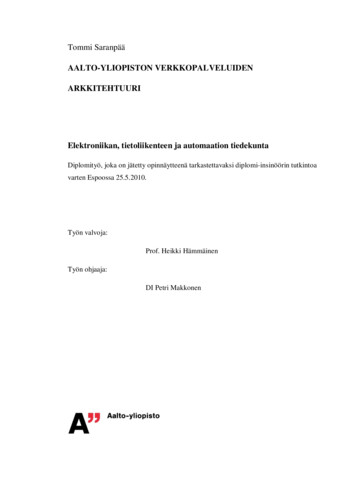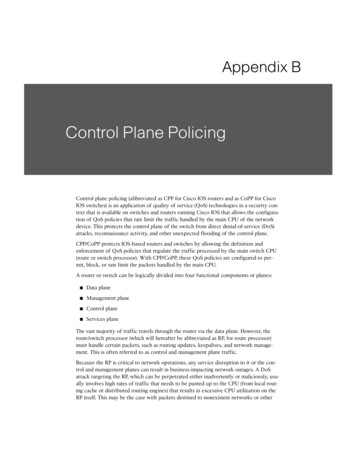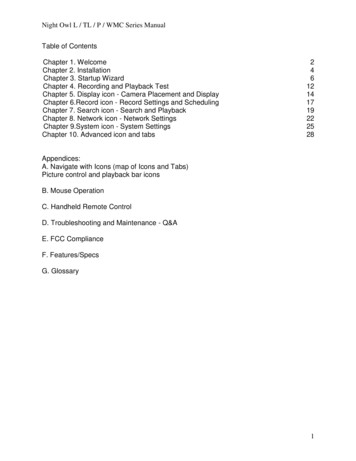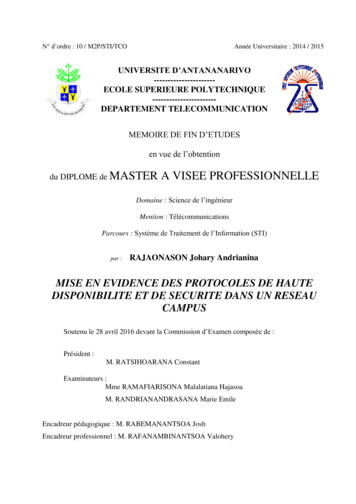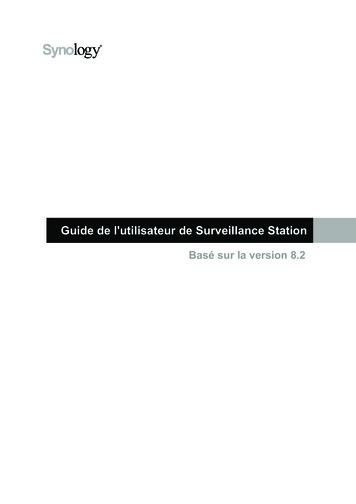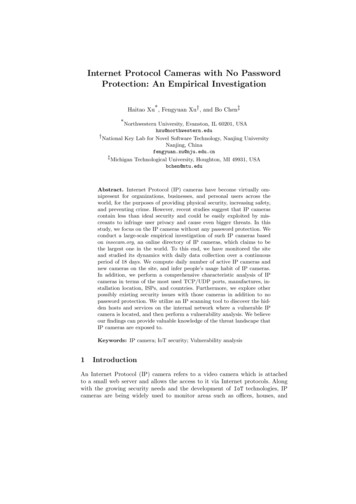
Transcription
Internet Protocol Cameras with No PasswordProtection: An Empirical InvestigationHaitao Xu* , Fengyuan Xu† , and Bo Chen‡* Northwestern University, Evanston, IL 60201, USAhxu@northwestern.edu† National Key Lab for Novel Software Technology, Nanjing UniversityNanjing, Chinafengyuan.xu@nju.edu.cn‡ Michigan Technological University, Houghton, MI 49931, USAbchen@mtu.eduAbstract. Internet Protocol (IP) cameras have become virtually omnipresent for organizations, businesses, and personal users across theworld, for the purposes of providing physical security, increasing safety,and preventing crime. However, recent studies suggest that IP camerascontain less than ideal security and could be easily exploited by miscreants to infringe user privacy and cause even bigger threats. In thisstudy, we focus on the IP cameras without any password protection. Weconduct a large-scale empirical investigation of such IP cameras basedon insecam.org, an online directory of IP cameras, which claims to bethe largest one in the world. To this end, we have monitored the siteand studied its dynamics with daily data collection over a continuousperiod of 18 days. We compute daily number of active IP cameras andnew cameras on the site, and infer people’s usage habit of IP cameras.In addition, we perform a comprehensive characteristic analysis of IPcameras in terms of the most used TCP/UDP ports, manufactures, installation location, ISPs, and countries. Furthermore, we explore otherpossibly existing security issues with those cameras in addition to nopassword protection. We utilize an IP scanning tool to discover the hidden hosts and services on the internal network where a vulnerable IPcamera is located, and then perform a vulnerability analysis. We believeour findings can provide valuable knowledge of the threat landscape thatIP cameras are exposed to.Keywords: IP camera; IoT security; Vulnerability analysis1IntroductionAn Internet Protocol (IP) camera refers to a video camera which is attachedto a small web server and allows the access to it via Internet protocols. Alongwith the growing security needs and the development of IoT technologies, IPcameras are being widely used to monitor areas such as offices, houses, and
public spaces. However, recent reports [8, 10, 11] and studies [12, 16] have shownthat IP cameras contain less than ideal security, and could be exploited andfully controlled by miscreants to infringe user privacy and even launch largescale DDoS attacks [4, 9, 14].Username and password is the most widely used form of authentication inpractice to prevent unauthorized access. However, an incredible number of IPcameras are found to have no password protection (or more exactly, with password of null or empty) and are having their live video feeds streamed on insecam.org, a popular website with hundreds of thousands of visitors daily.Most previous works mainly focus on summarizing various vulnerabilitiesof IP cameras and making suggestions on potential mitigation solutions. In thispaper, based on the data provided by the site insecam about its listed IP cameras,we conduct an in-depth, large-scale quantitative evaluation of vulnerable IPcameras with no password protection. Specifically, we performed daily collectionon insecam over a continuous period of 18 days. As a result, we observed 28,386unique IP cameras, from 31 timezones1 , 136 countries, and 25 manufacturers,streaming their live video feeds on insecam without awareness of IP cameraowners. In addition to those currently active IP cameras, we managed to exhaustand collect all the history records of IP cameras ever streaming on insecam, witha total number of 290,344. We then performed a comprehensively characteristicanalysis of those IP cameras and also conducted vulnerability analysis of theinternal networks where those IP cameras reside with an attempt to identifymore vulnerabilities.Our work is the first measurement study on IP cameras using insecam.orgas a possible data source. Based on the assumption that all the informationposted on insecam about the IP cameras is correct, we highlight the followingfindings: 1) there are about 20,000 to 25,000 active cameras shown on insecameach day and 215 new cameras are added daily on average; 2) 87.4% IP camerason insecam are from the three geographic regions - Europe, East Asia, andNorth America, while United States alone contributes 22.5% of those cameras;3) monitoring the on/off state of IP cameras could reveal usage habit of IPcameras; 4) more than a half of cameras are from the two manufacturers, Defewayand Axis; 5) a third of IP cameras use the port 80 to communicate to theiradministrative interface; 6) about a quarter of hosts where an IP camera resideshave remote access ports 22 (SSH) and 23 (Telnet) open, which make themmore vulnerable to attackers; 7) nearly all those cameras were running extremelyold and vulnerable web server software, most of which are found to bear tensof CVE (Common Vulnerabilities and Exposures) vulnerabilities. We believe ourfindings can provide valuable knowledge of the threat landscape that IP camerasare facing.1There are 39 different timezones currently in use in the world [6].2
2BackgroundIn this section, we briefly introduce IP cameras and the site insecam.org wherewe collected data.IP cameras. An IP camera contains a CPU and memory, runs software, andhas a network interface that allows it to communicate to other devices and beremotely controlled by users. Different from CCTV cameras (closed-circuit television cameras), IP cameras have the remote access features for administrationand video monitoring. However, the remote accessibility can be exploited by ahacker, especially when users adopt default settings and credentials for the webadministrative interface.insecam.org. This site is reported to have existed since September 2014. Itis claimed to be the world largest directory of network live IP video cameras. Thefirst time the site attracted media attention was in November 2014 [8, 10, 11],when journalists reported that the site provided a directory for countless privateIP cameras which streamed privacy-sensitive live video feeds. Since then, the siteadministrator seems to have enforced strict policies that only filtered IP camerascan be added to the directory. However, there are still hundreds of thousandsof IP cameras listed on the site without their owners’ awareness. In addition,all IP cameras on insecam are accessible without any authentication (i.e., nopassword protection) and the live video stream can be directly viewed by anyvisitors across the world.3Measurement Methodology and Datasetinsecam.org collects a large set of currently active IP cameras that have nopassword protection. And those cameras seem not to be remotely controlled orinterfered by insecam. According to the policy described on the homepage ofinsecam [7], anyone could request the site administrators to add an IP camerato the directory by providing the IP and port of the camera. For each activeIP camera, insecam streams its live video feeds on the site for visitors to watchand also provides relevant metadata information including the camera IP, port,manufacturer, geolocation information (country, city, and timezone), and a tagdescribing the subject of the video feed (e.g., animal, street) if available. An IPcamera turned off by its owner cannot be accessed on insecam, and thus the totalnumber of active cameras shown on insecam is always changing. In addition, eachIP camera is assigned a unique ID by insecam and the ID of an IP camera couldusually lead to a webpage displaying the IP camera metadata information.Our general goal is to evaluate the seriousness of security issues with vulnerable IP cameras through the study on insecam. Our measurement methodologyis driven by three specific goals. First, we wish to examine the dynamics of insecam in terms of daily number of active IP cameras and new cameras on the site.Second, we want to characterize those IP cameras without password protectionin terms of their manufacturers, installation location, ISPs, and countries. Third,we want to explore the possibility that a vulnerable camera could be leveragedas a pivot point onto the internal network.3
We built a Python crawler that allows us to automatically collect the information about the IP cameras posted on insecam. Considering the alwayschanging number of active cameras due to turning on or off, we ran the crawlerat least four times each day at six-hour time interval. The collected informationsuffices for our purposes of examining insecam dynamics and characterizing IPcameras, except the information about what ISPs are hosting those vulnerableIP cameras. We then queried the IP addresses of insecam cameras in an onlineIP geolocation database [5] to obtain the corresponding ISP information.In addition, based on the observation that the camera IDs on insecam are allintegers and the camera IDs in our collected dataset have many missing values,we assume that insecam assigns sequential IDs to its cameras, and conjecturethat those missing camera IDs correspond to the IP cameras which were evercollected on insecam but are currently not accessible due to either no longerworking or password setup. We ran the crawler to request the correspondingweb pages for the camera metadata information. In this way, we believe we areable to exhaust or at least very close to collect all the history records of IPcameras ever appearing on insecam.We also utilized an IP scanning tool [1] to discover the hidden hosts andservices which co-reside with the vulnerable IP cameras in the same internalnetwork. We paid special attention to the services (e.g., SSH and Telnet) whichare often probed by attackers as the starting point for further attacks. We thenperformed vulnerability analysis based on the collected co-residing information.Dataset. Through daily data collection over a continuous period of 18 days,from September 25, 2017 to October 12, 2017, we have observed 28,386 unique,active IP cameras listed on insecam, which are from 31 timezones, 136 countries,and 25 manufacturers. For each of them, we collected its metadata informationdisplayed on insecam, and probed it several times a day in the following daysto determine its on/off state at that time. In addition, based on the observationthat the minimum and maximum values of the IDs assigned by insecam forstill active IP cameras are 1 and 560,293, respectively, we queried all cameraIDs falling within [1, 570, 000] one by one in insecam, and finally were able tocollect the metadata information for 290,344 IP cameras (28,386 active onesincluded), for each of which insecam still maintains a webpage. We conjecturethat insecam at least has posted 560,293 unique, vulnerable IP cameras in thepast three years since the website was created; currently 290,344 (51.8%) of themstill left “crumbs” for us able to track, and the reason why the information aboutthe rest 48.2% cameras is totally missing on insecam is still an open question; thecurrently active IP cameras only occupy at most 5.1% (28,386 out of 560,293)of all IP cameras ever disclosed by insecam.Ethical Consideration. In our study, we collect data from insecam, a publicly available website, for 18 days. During our data collection, we did not receiveany concerns or get warnings from insecam. In addition, we anonymized the collected metadata information before using it for study. We strictly abide by thecopyright licenses if present. Therefore, our work will not introduce any additional risk to insecam or the owners of the IP cameras listed on insecam.4
4Dynamics of 0009/27/201720,0009/26/2017# New Cameras30,0009/25/2017# active IP camerasWe examined the dynamics of insecam based on collected data and present thefindings as follows.Fig. 1: Daily active IP cameras with dates. Fig. 2: Daily new IP cameras with dates.4.1Daily Active IP Cameras Listed on InsecamFigure 1 shows the number of daily active IP cameras in the time period duringwhich we ran our crawler. We can see that there are about 20,000 to 25,000active cameras shown on insecam each day. Those cameras only represent thetip of the iceberg, since the site administrator claimed to have filtered out allcameras which may invade people’s private life. Furthermore, any visitors toinsecam have direct access to the live video feeds of those cameras from acrossthe world, which suggests a very serious privacy issue caused by IP cameras withno password protection.4.2Daily New Cameras Added on InsecamThe number of daily new cameras reflects the popularity of insecam, to someextent. We also examine how many new cameras are added to insecam daily. Bynew cameras, we mean the cameras which IP addresses are not seen before inour current dataset. It is possible that an IP camera could have a different IPaddress if DHCP is enabled. Considering the claim made by insecam that all IPcameras are manually added, we assume that the use of DHCP would not causethe same IP camera to be given a new camera ID. We reached out to the siteadmin to confirm but received no response.Figure 2 shows the number of daily new cameras on insecam in the timewindow we monitored. The daily new camera number varies greatly with date,with the maximum of 537, the minimum of 67, and the average number of 215.Thus, insecam seems to have developed quite well since November 2014, at thetime insecam was rebuked by many medias [8, 10, 11].4.3Top Timezone with Most Cameras Collected on InsecamIP cameras on insecam are well organized by timezone. We would like to knowwhich geographic areas contribute most cameras to insecam. We confirmed that5
5,80020%5,6004,00015%3,00010%2,000(UTC 08:00) East Asia Time(UTC 09:00) NorthEast Asia(UTC 02:00) E. Europe Time(UTC) Greenwich Time(UTC 01:00) W. EuropeTime(UTC-04:00) Atlantic Time(UTC-05:00) Eastern Time0%(UTC-06:00) Central Time0(UTC-07:00) Mountain Time1,0005%# active IP cameras25%5,000(UTC-08:00) Pacific Time# average IP camera number at any time6,0005,4005,2005,0004,8004,6000 1 2 3 4 5 6 7 8 9 10 11 12 13 14 15 16 17 18 19 20 21 22 23Hour (UTC 01:00 W. Europe)(a)(b)Fig. 3: (a) Top timezones with the most cameras posted on insecam. (b) The averagenumber of active IP cameras in the hour (local time) of a day in UTC 01:00, WestEurope.the geolocation information provided by insecam is correct by comparing thegeolocation information shown on insecam with the information returned byMaxmind for the same IP. Figure 3(a) depicts top 10 timezones with the mostIP cameras disclosed on insecam. The timezone UTC 01:00, mainly representingWestern Europe, contributes the most cameras and has 5,186 active cameraslisted on average at a time, occupying 23.1% of all active cameras worldwide.The timezone UTC 02:00, mainly referring to Eastern Europe, comes second,with the average number of 4,522 cameras. The third and fourth timezones areUTC 09:00 (Northeast Asia) and UTC-05:00 (Eastern America), with 2,414and 2,186 active cameras on average, respectively. In summary, the three geographic regions - Europe, East Asia, and North America - contribute the mostIP cameras on insecam, 87.4% in total.4.4Usage Habit of IP Cameras within a DayDuring our several times of polling of an IP camera within a day, we alwaysobserved that a proportion of IP cameras become inaccessible within some timeperiod. We conjecture that the IP camera owners may often turn off their cameras during some time period in a day. Thus, we would like to examine thediurnal pattern of usage of IP cameras within a day.We analyze the change in the average number of active IP cameras per hourwithin a single day throughout the 18 days for the timezone UTC 01:00, the onewith the most IP cameras on insecam, and illustrate the results in Figure 3(b). Itclearly shows that the number of active IP cameras2 does change with the hourof the day. Specifically, there are more IP cameras to be on during the nighttimeperiod from 17:00 in the afternoon to 5:00 in the next early morning, exceptthe time 19:00, probably an outlier. And the active IP camera number peaks at1:00am. In contrast, there are fewer IP cameras on in the daytime, from 6:00 to16:00 in the figure. The finding seems reasonable given that the main purposeof IP cameras is to increase safety and prevent crime.2Active IP cameras refer to the IP cameras whose video feeds are accessible online.6
5Characterization of Insecam IP CamerasIn this section, we examine various characteristics of the IP cameras listed on insecam. We want to answer the following questions: 1) what countries are havingthe most vulnerable IP cameras without password protection, 2) what organizations are hosting those cameras, 3) where are they being installed, 4) what arethe manufacturers of those cameras, and 5) what TCP/UDP ports are used byIP cameras for communication to its administrative interface.5.1Top Countries and ISPs Contributing Insecam IP Cameras# IP cameras on insecamAs mentioned before, the currently active IP cameras on insecam are from up to136 countries, that is, 209 IP cameras on average per country. Figure 4(a) showsthe top 10 countries which contribute 61.2% IP cameras on insecam. UnitedStates tops the list and has more than 4,500 IP cameras listed on insecam,22.5% out of all insecam cameras. Turkey and Japan come second and third,with 1,604 and 1,303 IP cameras, respectively. It seems that all the top 10countries are either developed countries or countries with large t Cable (United States)20%6.3%4.7%3.7%3.0%2.8%2.5%2.4%5%2.4%Virgin Media (United Kingdom)10%5.6%2.5%Verizon Wireless (United States)15%7.7%2.4%Spectrum (United States)1.8%TurkTelecom (Turkey)4.7%TurkTelekom (Turkey)1.6%OCN NTT Communications Corp. (Japan)1.2%Interbusiness (Italy)0%2.3%Deutsche Telekom AG (Germany)1.2%ProXad network / Free SAS (France)1.5%0%2%4%6%Fig. 4: (a) Top 10 countries contributing the most IP cameras on insecam. (b) Top 10ISP responsible for the IP addresses of insecam cameras.By querying the IP addresses of insecam cameras in an online IP geolocation database [5], we obtain the corresponding ISP information. There are 4,094unique ISPs responsible for the IP addresses of insecam cameras. Figure 4(b)provides the top 10 ISPs and their origin countries. Reasonably, the top ISPsbelong to the top 10 countries in Figure 4(a). Specifically, three out of the top10 ISPs are from United States, which are Comcast, Spectrum, and Verizon.In addition, up to 296 (7.2%) ISPs could be identified to be universities andcolleges, from 26 countries.5.2Installation Locations of Insecam IP Camerasinsecam assigns a tag describing the subject or installation location of the videofeed (e.g., animal, street). We verified the correctness of the installation locationinformation provided on insecam by manually viewing tens of camera live feeds.Based on the tag information associated with 7,602 IP cameras, we present the7
700countpercentage# IP %# IP cameras800Fig. 5: (a) Top 20 installation places of the insecam cameras. (b) Top 10 manufacturersof those insecam cameras.distribution of insecam IP cameras by installation location in Figure 5(a). Itshows that most IP cameras are being installed in public places such as street,city, beach, mountain, and parking lots, and only a small proportion are deployedin private areas such as pool, office, and house. However, the results do not reflectthe whole picture of vulnerable IP cameras in the world, given that insecam wasalmost shut down by authorities in 2014 due to too many private IP camerasbeing streamed on the site at that time [8,10,11] and that the site administratorclaims in the home page that only filtered cameras are available on the site andthe site does not stream private or unethical cameras. Nevertheless, the videofeeds of a significant proportion of current active insecam cameras still containprivacy-sensitive content.5.3Manufacturers of Insecam CamerasThe complicated manufacturing and distribution chain in the IP camera markethas resulted in too many vendors selling IP cameras. We are not sure about howinsecam gets the manufacturer information of an IP camera or whether suchinformation is correct. But we observe that the access URL to video feeds ofan IP camera could be used for fingerprinting the manufacturer information.For instance, axis-cgi/mjpg/video.cgi, the substring of such a URL, indicates that a camera is manufactured by Axis. We manually inspected severalpieces of manufacturer information provided by insecam and verified that theyappear correct. We provide the distribution of those insecam IP cameras bymanufactures in Figure 5(b). Among the 20,923 IP cameras with the manufacturer metadata information, the two manufacturers Defeway and Axis dominatethe cameras, occupying 29% and 22.7%, respectively. Most other manufacturersoccupy no more than 5% each.5.4TCP/UDP Ports Used by Insecam CamerasWe also examined on which port an insecam IP camera is working. Figure 6(a)provides the top 10 most used ports by insecam IP cameras. The top 10 ports are80-84, 8000, 8080-8082, and 60001. Port 80 (HTTP) is the most used port by IPcameras to communicate to their administrative interface, occupying 32.8%. Theuncommon port 60001 comes second, occupying about 15%. Further examination8
# Unique Camera .70.60.50.40.30.20.10012345678910Number of Ports (Used by Cameras) Associated with an IPFig. 6: (a) Top 10 ports used by insecam cameras. (b) CDF of the number of portsper IP address of insecam 15,00010,0005,000016.1%9.0%5.5% 5.3% 4.7%4.5% 4.1% 3.9%3.5% 3.0%18%16%14%12%10%8%6%4%2%0%Probability# IP Cameras Ever on insecamreveals that 96.5% of insecam cameras using port 60001 are Defeway cameras,which is interesting since the port seems to have the power of fingerprinting themanufacturer of an IP camera and thus could be exploited by miscreants.One IP address could be associated with multiple IP cameras, with each oneusing a different port. Figure 6(b) gives the cumulative distribution function(CDF) of the number of ports used by IP cameras (i.e., the number of insecamIP cameras) associate with one IP address. It shows that 87.5% IP addressesare connected with only one IP camera, about 10% IP addresses are associatedwith two IP cameras, and 3% IP addresses are connected with three or moreIP cameras. Note that the results represent a lower bound of the number of IPcameras associated with an IP address, since it is quite probable that an IPaddress is indeed connected with multiple cameras but only one IP camera isknown by insecam.10.90.80.70.60.50.40.30.20.100 1 2 3 4 5 6 7 8 9 10 11 12 13 14 15 16 17 18 19 20Total Number of Open Ports Associated with a Camera IPFig. 7: (a) Top 10 countries ever contributing the most IP cameras on insecam. (b)CDF of the number of ports per IP address of insecam cameras.5.5Exhaust Historical IP Cameras Ever Posted on InsecamIn addition to the currently available and active IP cameras on insecam, wemanage to exhaust or at least very close to collect all the history records ofIP cameras ever appearing on insecam. We were able to collect the metadatainformation for 290,344 IP cameras (28,386 active ones included), and presentthe distribution of those cameras by country in Figure 7(a).9
The figure shows the top 10 countries which have the most IP cameras everdisclosed on insecam since the creation of insecam in September 2014. We can seethat 9 out of the 10 countries have had more than 10,000 vulnerable IP camerasposted by insecam. United States still tops the list, with more than 45,000 IPcameras ever posted. China comes second, with more than 25,000 IP camerasever listed on the site, which is quite strange given our current observation thatonly 188 insecam IP cameras on average at any specific time are from China.It is still unknown why there is a huge decrease in the number of IP camerasfrom China on insecam. One clue is that the insecam administrator points outtwo ways out for an IP camera, which are either contacting him to remove IPcameras from insecam or simply setting the password of the camera. Comparedwith the current top 10 countries shown in Figure 4(a), Viet Nam and Brazilalso appear in the top 10 countries which contribute the most vulnerable camerason insecam in the past several years.6Vulnerability Analysis of Internal Network of IPCamerasIn addition to the vulnerability of no password protection, we would like toexplore other possible vulnerabilities of those insecam IP cameras from the perspective of a real attacker. To this end, we first utilized an IP scanning tool [1]with an attempt to discover the hidden hosts and services co-residing in the sameinternal network as the vulnerable IP cameras. Specifically, the tool sends probesto an IP address and returns information including 1) whether the host is up,2) responding TCP and UDP port numbers, 3) the services and their versionsbehind open ports, and so on. We may run the tool on an IP address multipletimes to make sure that the host is not down so that we can gather the relevantinformation.6.1Open PortsNumber of Open Ports per IP Address. We first examine the open portsassociated returned for an IP address. Figure 7(b) depicts the CDF of the numberof open ports associated with the IP address of an IP camera. We can see thatan IP camera often has several other open ports. Specifically, 38.5% IP addressesseems to be exclusively used for IP cameras; more than 60% IP addresses haveat least two open ports; about 40% IP addresses have three or more open ports;about 10% IP addresses have at least 6 open ports. On average, an IP addresshas 3 open ports. 31 IP addresses have more than 100 open ports, and 14 IPaddresses have more than 200 open ports.Remote Access Ports. In addition, we paid special attention to the services(mainly SSH and TELNET) which tend to be exploited by attackers for maliciousactivities such as DDoS attacks. Mirai, the IoT-based botnet that took theInternet by storm in late 2016, was found to harvest bots by sending probes onTCP ports 22 (SSH) and 23 (TELNET) [14]. In our test, 22.4% of alive hosts (i.e.,10
00CountPercentage18%16%14%12%10%8%6%4%2%0%% of all IP cameras with web serversdetected# unique camera IP addressesresponding to pings) have ports 22 and/or 23 open. These remote access portsmake those IP cameras vulnerable to the Mirai-like attacks.25%21.4%20%15%10%5%15.1%11.7%7.2% 6.2% 6.2%4.7% 3.9% 3.7%2.5%0%Fig. 8: (a) Top 15 most common open ports on the host of an insecam camera. Wordsin parentheses denote the corresponding protocols or services running on the ports.(b) Top 10 most popular web servers of insecam IP cameras. Numbers in parenthesesdenote the number of web server versions.Most Common Open Ports. Figure 8(a) shows the top 15 most commonopen ports on the host of an insecam IP camera. Compared to Figure 6(a), thereare many more kinds of port numbers (services) commonly accessible on the IPcamera host, such as 21 (FTP), 22 (SSH), 23 (TELNET), 443 (HTTPS), 554 (RTSP),and 1723 (PPTP). Some services are directly related to IP cameras, includingHTTPS, RTSP, and PPTP, while some services could be easily exploited by attackersas a pivot point to the internal network, such as FTP, SSH, and TELNET, especiallywhen the co-residing IP cameras could be directly accessed due to no passwordprotection.6.2Web ServersWith the help of the IP scanning tool, we are able to detect a total of 300 differentversions of web servers use by 2,564 IP cameras. The different versions of webservers were then aggregated to the web server software. Figure 8(b) shows thetop 10 web server software used by IP cameras. Numbers in parentheses denotethe number of web server versions used. Specifically, four different versions ofBoa web server software are used most, about 21.4%. Apache HTTP server is alsoprevalent, and up to 34 versions were used by 15.1% IP cameras. The thttpdweb server software comes third, with 11.7% rate.Furthermore, we studied the release dates of the popular versions of webservers as well as the number of known CVE (Common Vulnerabilities and Exposures) vulnerabilities contained in them. We found that nearly all those cameraswere running extremely old and vulnerable web server software. For example,the most popular web server software, Boa, has been discontinued since 2005 [3].Most popular web servers have been found to bear a significant number of CVEvulnerabilities. Specifically, all 34 versions of Apache HTTP server have 3 to 4911
vulnerabilities, and 19 vulnerabilities on average [2]. All the two thttpd webserver versions contain 2 to 3 vulnerabilities. All 8 Microsoft IIS versions contain 1 to 9 vulnerabilities, and 5 on average. 84.6% (11 out of 13) nginx webserver versions used have 1 to 3 known vulnerabilities. Such vulnerabilities couldinclude authentication bypass vulnerability, cross-site scripting (XSS) vulnerability, buffer overflow, directory traversal, and many other vulnerability types.They allow attackers to gain administrator access and execute arbitrarily malicious code on IP
study, we focus on the IP cameras without any password protection. We conduct a large-scale empirical investigation of such IP cameras based on insecam.org, an online directory of IP cameras, which claims to be the largest one in the world. To this end, we have monitored the site and studied its dynamics with daily data collection over a continuous
